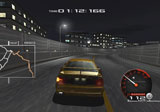 Crave’s Tokyo Xtreme
Racer series takes players down into Tokyo’s underground street racing circuit. There
are no rules and no hot models waving a checkered flag. It’s just you, your pumped-up
muscle car, and, if you are good, a wad of cash. TXR Zero is certainly a different kind of
racing game—part arcade racer, part sim, part fighting game (yes, fighting game). But
different can be good, and this game is very good.
Crave’s Tokyo Xtreme
Racer series takes players down into Tokyo’s underground street racing circuit. There
are no rules and no hot models waving a checkered flag. It’s just you, your pumped-up
muscle car, and, if you are good, a wad of cash. TXR Zero is certainly a different kind of
racing game—part arcade racer, part sim, part fighting game (yes, fighting game). But
different can be good, and this game is very good.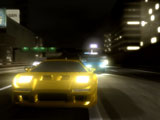 Essentially, the premise
plays out like this: late at night, when traffic is scarce, you take your car onto the
Tokyo highways and search for rival racers. When you find a potential competitor, pull up
behind them and flash your brights. If he or she accepts your challenge, the race is on.
It’s a simple concept fleshed out to be one of the best arcade/sim racers I have ever
played. Usually the two don’t mix well, but in this case the complex system of
upgrades, tweaks, and adjustments made to your car only enhances the arcade action.
Essentially, the premise
plays out like this: late at night, when traffic is scarce, you take your car onto the
Tokyo highways and search for rival racers. When you find a potential competitor, pull up
behind them and flash your brights. If he or she accepts your challenge, the race is on.
It’s a simple concept fleshed out to be one of the best arcade/sim racers I have ever
played. Usually the two don’t mix well, but in this case the complex system of
upgrades, tweaks, and adjustments made to your car only enhances the arcade action.
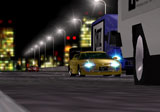 The
action is intense. This is due, in most part, to a creative race set-up and fantastic AI.
The race set-up is such that shortly after you flash your brights and enter a challenge,
two power meters appear on your HUD. The meters behave much as they would in your typical
fighting game. Your opponent’s meter will deplete as long as you remain in the lead,
will deplete faster if you put more distance between the two of you, and vice versa. Your
meter also depletes when you run into objects—a little bit if you graze another car,
a lot if you run straight into a wall. Style is factored in with speed. This makes for
relatively fast races (a longer race runs about 90 seconds), but as the onscreen map
indicates your rivals, the next challenge is usually just around the corner.
The
action is intense. This is due, in most part, to a creative race set-up and fantastic AI.
The race set-up is such that shortly after you flash your brights and enter a challenge,
two power meters appear on your HUD. The meters behave much as they would in your typical
fighting game. Your opponent’s meter will deplete as long as you remain in the lead,
will deplete faster if you put more distance between the two of you, and vice versa. Your
meter also depletes when you run into objects—a little bit if you graze another car,
a lot if you run straight into a wall. Style is factored in with speed. This makes for
relatively fast races (a longer race runs about 90 seconds), but as the onscreen map
indicates your rivals, the next challenge is usually just around the corner.
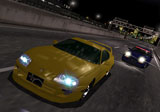 Amazingly,
the AI not only keeps up this pace, it helps to produce it. Crave has done an incredible
job of creating aggressive opponents who will seize any opportunity to take the inside
corner, box you in behind slower moving cars, or run you into walls. The rivals in this
game are neither predictable nor perfect, and while you will blow by many of the early
racers, the more sophisticated rivals, especially members of the "13 Devils
Gang," require you to find their weaknesses and exploit them.
Amazingly,
the AI not only keeps up this pace, it helps to produce it. Crave has done an incredible
job of creating aggressive opponents who will seize any opportunity to take the inside
corner, box you in behind slower moving cars, or run you into walls. The rivals in this
game are neither predictable nor perfect, and while you will blow by many of the early
racers, the more sophisticated rivals, especially members of the "13 Devils
Gang," require you to find their weaknesses and exploit them.
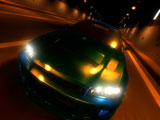 Some
are likely to take issue with TXR Zero’s driving mechanics, as they are somewhere
between your average sim and arcade racers. They can be adjusted in the options menu,
however, and become fairly intuitive with practice. The analog stick on the PS2 Dual Shock
Controller handles well, and the L1/R1 shift up/shift down functions are perfect. This is
not the kind of game you can play well in automatic. The first time you come across a hole
in traffic that is big enough to accommodate one car, and your opponent defeats you by
downshifting and flying through it while you are stuck in high gear. A couple of plays,
and you will know what I mean. Again, yes, the AI is that good.
Some
are likely to take issue with TXR Zero’s driving mechanics, as they are somewhere
between your average sim and arcade racers. They can be adjusted in the options menu,
however, and become fairly intuitive with practice. The analog stick on the PS2 Dual Shock
Controller handles well, and the L1/R1 shift up/shift down functions are perfect. This is
not the kind of game you can play well in automatic. The first time you come across a hole
in traffic that is big enough to accommodate one car, and your opponent defeats you by
downshifting and flying through it while you are stuck in high gear. A couple of plays,
and you will know what I mean. Again, yes, the AI is that good.
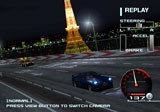 My primary complaint about gameplay is the collisions. This is not the kind of
game where cars take physical damage (which would have been fun, but its absence is
forgivable as collisions are factored into the power meters). The cars more or less reel,
careen, slow down, or stop altogether. Sometimes these scrapes are, well, not believable,
but at least they behave with a modicum of logic. At other times your guess is as good as
mine. The worst comes when your car crashes head-on with something, jarring it into a
complete stop. For some inexplicable reason, when this happens the camera swings around,
looking at the front of your car, which reverses your controls during one of the most
nerve-racking moments in the game, certainly not a situation in which you want to spend
precious time adjusting to directional changes.
My primary complaint about gameplay is the collisions. This is not the kind of
game where cars take physical damage (which would have been fun, but its absence is
forgivable as collisions are factored into the power meters). The cars more or less reel,
careen, slow down, or stop altogether. Sometimes these scrapes are, well, not believable,
but at least they behave with a modicum of logic. At other times your guess is as good as
mine. The worst comes when your car crashes head-on with something, jarring it into a
complete stop. For some inexplicable reason, when this happens the camera swings around,
looking at the front of your car, which reverses your controls during one of the most
nerve-racking moments in the game, certainly not a situation in which you want to spend
precious time adjusting to directional changes.
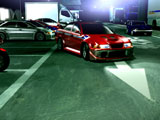 The
list of options in TXR Zero is by far the most impressive of the series. You can choose to
play in Quest Mode, Quick Race, Time Attack, Free Run, or two player Versus (something
that was lacking before). In Quest Mode, the meat of the game, you begin with a limited
amount of cash, your choice of 36 cars, and four sections of highway on which to race. As
you defeat the nearly 400 rival racers, your cash flow will grow, the number of cars will
increase to as much as 125, and you will unlock more and more of the highway. In addition
to this there is the Parts Shop, where you can beef up your car’s specs in terms of
Power (Engine and Muffler), Drive Train (Transmission, Clutch, Differential), Body (Roll
Cage), Aerodynamics (Side Walls, Spoiler, etc.), Dress Up (Headlights, Wheels, etc.),
Color, and Decals. Don’t be fooled by lesser arcade/sims of the past—these
tune-ups actually do affect the handling of your car. I couldn’t tell you how
realistic these effects are, but they are dynamic. And you can buy, save, and augment as
many cars as you can afford. All of this lends replay value to what otherwise would have
been a series of short sprint races. The best addition has to be the Versus Mode that
allows each player to load a previously saved game and race one painstakingly personalized
muscle car against another.
The
list of options in TXR Zero is by far the most impressive of the series. You can choose to
play in Quest Mode, Quick Race, Time Attack, Free Run, or two player Versus (something
that was lacking before). In Quest Mode, the meat of the game, you begin with a limited
amount of cash, your choice of 36 cars, and four sections of highway on which to race. As
you defeat the nearly 400 rival racers, your cash flow will grow, the number of cars will
increase to as much as 125, and you will unlock more and more of the highway. In addition
to this there is the Parts Shop, where you can beef up your car’s specs in terms of
Power (Engine and Muffler), Drive Train (Transmission, Clutch, Differential), Body (Roll
Cage), Aerodynamics (Side Walls, Spoiler, etc.), Dress Up (Headlights, Wheels, etc.),
Color, and Decals. Don’t be fooled by lesser arcade/sims of the past—these
tune-ups actually do affect the handling of your car. I couldn’t tell you how
realistic these effects are, but they are dynamic. And you can buy, save, and augment as
many cars as you can afford. All of this lends replay value to what otherwise would have
been a series of short sprint races. The best addition has to be the Versus Mode that
allows each player to load a previously saved game and race one painstakingly personalized
muscle car against another.
TXR Zero looks and sounds great, though it cannot compete with GT3 on either level.
However, the detail is there, in the high-gloss, reflective surfaces of the cars and
realistic road surfaces. The controller even kicks in a little vibration in key moments,
as when your car crosses the seams in a highway bridge. And there is no slowdown
whatsoever. The environment is a very convincing recreation of the Tokyo skyline, but it
suffers from obvious draw-in most of the time, especially when dealing with taller
buildings. Yet the biggest problem is a glaring lack of variety. The races only take place
at night, only in Tokyo, and eventually it all gets pretty monotonous.
And that is where this game falls short of its potential—it has a tendency toward
monotony. Same time of day, same city, same concrete racing environment. No weather
effects, no dramatic light sources. And where are the cops? There is a missed opportunity:
outracing and outsmarting cops along with your opponents. What if you were able to slow
down when you saw a cop in the distance, and your opponent would lose due to his or her
being arrested? All of these things would add new dimensions to gameplay and strategy.
Plus, they would be really cool. Yet, as I continue to play this game, fully aware of what
it lacks in terms of variety, it still draws me in every time. Despite its shortcomings,
the car configuration is effective, and the races are electrifying. Even with GT3 looming
on the horizon, you could do worse than pick up this game. It is just plain fun, a
phenomenon we have been seeing more of on the PS2 lately, and I, for one, am happy.
